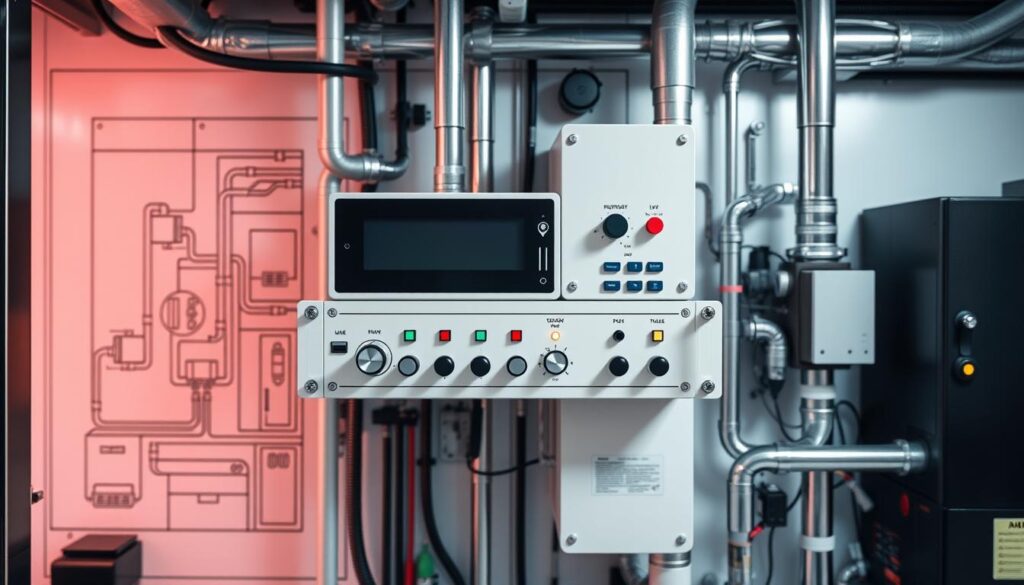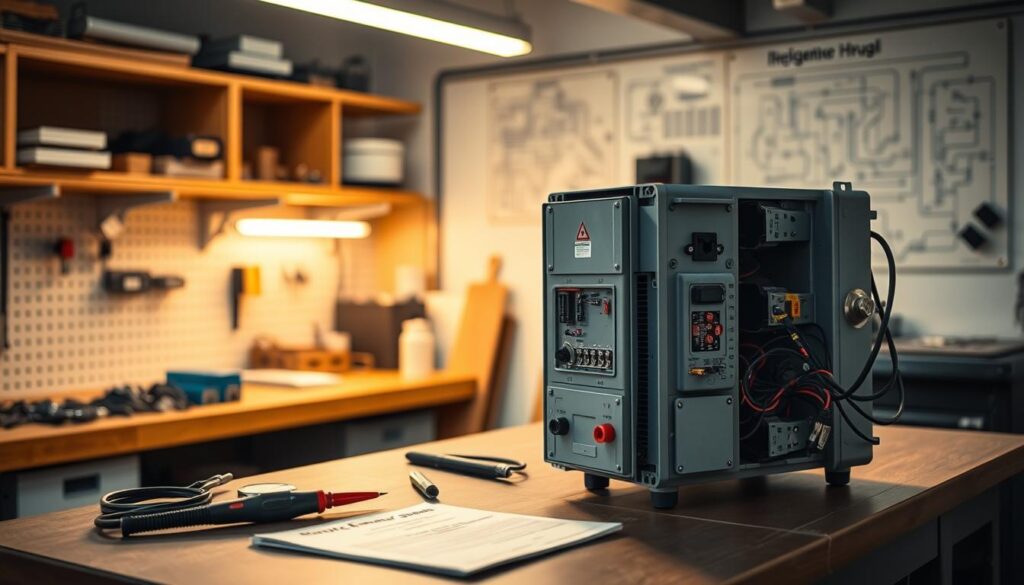Affiliate Disclosure
HVAC Guide Guys is a participant in the Amazon Services LLC Associates Program, an affiliate advertising program designed to provide a means for sites to earn advertising fees by advertising and linking to Amazon.
What Is A Sequencer HVAC? Ever thought about how your HVAC system avoids electrical overload and manages power well? It’s thanks to a small but key part called an HVAC sequencer.

An HVAC sequencer is a vital electrical circuit in your heating and cooling system. It makes sure power is shared right across different parts of the system. This keeps everything running smoothly and efficiently, without the risk of shutting down.
Imagine a sequencer as the conductor of an electrical orchestra. It controls when and how power goes to different parts of your HVAC system. This small device is key to avoiding electrical overload and keeping your system running at its best.
Key Takeaways
- HVAC sequencers prevent electrical system overload
- Controls power distribution across system components
- Essential for maintaining efficient heating and cooling
- Protects electrical circuits from damage
- Enables systematic startup and operation of HVAC systems
Table of Contents
Understanding HVAC Sequencer Basics
A furnace sequencer is key to your heating system’s performance and efficiency. It controls electrical and mechanical processes in HVAC systems.
The sequencer ensures energy is distributed smoothly and efficiently. It manages electrical components to avoid overloads and boost system performance.
Key Components of Sequencer Systems
Sequencer systems have important parts:
- Electrical control board
- Timing mechanism
- Load management circuits
- Temperature sensors
- Relay switches
Installation and Location Requirements
Where you place your sequencer matters for HVAC performance. They are usually installed:
- Near the main electrical panel
- In climate-controlled environments
- Away from direct moisture
- Accessible for maintenance
Primary Functions in HVAC Control
The main roles of a sequencer are:
| Function | Purpose |
|---|---|
| Load Balancing | Distribute electrical load evenly |
| Timing Control | Manage component activation sequences |
| Overload Prevention | Protect electrical systems from surge damage |
Understanding these basics helps you appreciate the sophisticated technology working behind your heating system’s seamless operation.
Explore Our HVAC Shop
Looking for top-rated HVAC tools, parts, and accessories? Visit our shop and find the perfect solution for your needs.
Visit the ShopWhat Is A Sequencer HVAC
A sequencer HVAC is a key device that controls power in heating and cooling systems. It ensures electrical parts in your HVAC system work right. Knowing how it works shows its role in keeping your system running well and safely.
The main job of a sequencer is to avoid electrical overload. It manages power to different parts of your system. When your electric furnace starts, the sequencer makes sure heating elements turn on one at a time.
This method helps:
- Lower sudden power spikes
- Lessen electrical stress on the system
- Make HVAC parts last longer
- Boost energy efficiency
Replacing an electric furnace sequencer is needed when it wears out or breaks. Homeowners should look out for signs like uneven heating, frequent circuit breaker trips, or odd system behavior. HVAC experts can find and replace sequencers to get your system working its best.
A well-functioning sequencer is like a traffic controller for your HVAC system’s electrical components, ensuring smooth and controlled power distribution.
Sequencers manage power well, protecting your HVAC investment. They help keep your home comfortable and save energy.
How HVAC Sequencers Operate
An HVAC sequencer is key in managing your heating system’s power. It acts as a smart controller, coordinating the start of electrical heating in your system.
This device prevents electrical overload and ensures smooth heating. When your thermostat calls for heat, it controls the timing of electric heating with great precision.
Step-by-Step Activation Process
Your HVAC sequencer works in a detailed process:
- Receives initial signal from thermostat
- Evaluates current electrical load
- Activates heating elements in a controlled sequence
- Manages power distribution to prevent sudden surges
Timing and Delay Mechanisms
Timing is everything for your system’s performance. The sequencer adds strategic delays between turning on components, usually 10 to 30 seconds.
| Timing Stage | Duration | Purpose |
|---|---|---|
| Initial Delay | 10-15 seconds | Prevent electrical surge |
| Component Activation | 15-20 seconds between elements | Distribute electrical load |
| Final Stabilization | 5-10 seconds | Ensure smooth operation |
Power Distribution Control
The sequencer is a smart power manager. It controls electrical current to heating parts with precision. This careful control prevents circuit overload and extends your HVAC system’s life.
Types of HVAC Sequencers
It’s important to know about the different HVAC control sequencers. They help keep your heating and cooling systems running well. Each sequencer has its own role in how your HVAC equipment works and uses energy.
When looking at sequencers versus relays in HVAC systems, there are four main types. Each one has its own special function:
- Electronic Sequencers: Give precise digital control and timing for many HVAC parts
- Timed Sequencers: Control when equipment starts and stops with set times
- Guardian Sequencers: Protect against too much electrical current
- Direct Replacement Sequencers: Make upgrading systems easy
Each sequencer type has its own benefits for your HVAC system. Electronic sequencers are great for modern systems with lots of control needs. Timed sequencers are better for older setups.
| Sequencer Type | Primary Function | Best Application |
|---|---|---|
| Electronic | Precise Digital Control | Complex HVAC Systems |
| Timed | Scheduled Component Activation | Standard Residential Systems |
| Guardian | Electrical Protection | High-Load Environments |
| Direct Replacement | Quick System Upgrade | Existing HVAC Configurations |
Choosing the right HVAC control sequencer depends on your system’s needs, energy goals, and budget.
Explore Our HVAC Shop
Looking for top-rated HVAC tools, parts, and accessories? Visit our shop and find the perfect solution for your needs.
Visit the ShopBenefits of Installing a Sequencer System
A sequencer is more than just a part of your HVAC system. It’s a game-changer that boosts your heating and cooling efficiency. Knowing how a sequencer works can help you get the most out of your system and save money.
Adding a sequencer to your heating system brings many benefits. It’s not just about managing power. Let’s look at why this technology is so valuable for both homes and businesses.
Energy Efficiency Advantages
A sequencer makes your HVAC system use less energy by:
- Controlling electrical load distribution
- Preventing simultaneous high-power startup
- Reducing unnecessary energy waste
- Optimizing power consumption across different components
“Smart power management is the key to energy-efficient HVAC systems.” – HVAC Engineering Professionals
Component Protection Features
The sequencer in heating systems also protects your HVAC equipment. It manages power to prevent:
- Electrical overloading
- Premature component wear
- Unexpected system shutdowns
- Potential electrical damage
Cost-Saving Benefits
Getting a sequencer can save you money in many ways:
- Reduced electricity bills
- Extended equipment lifespan
- Lower maintenance costs
- Minimized repair expenses
By smartly managing your HVAC system’s power, a sequencer is key for saving energy and money.
Common Issues and Troubleshooting
Understanding common problems with HVAC sequencer systems is key to keeping them running well. Troubleshooting the sequencer relay needs a step-by-step method to find and fix electrical issues fast.

Several common issues with electric furnace sequencers need quick action:
- Inconsistent heating patterns
- Unexpected system shutdowns
- Electrical connection failures
- Delayed heating activation
When these issues keep happening, it might be time to replace the electric furnace sequencer. Important steps to diagnose problems include:
- Checking power supply connections
- Inspecting relay contact points
- Measuring electrical resistance
- Evaluating timing mechanisms
Signs that your sequencer might be having trouble include:
- Uneven room temperatures
- Frequent circuit breaker tripping
- Unusual clicking sounds during system startup
- Extended heating cycle times
Professional technicians recommend regular inspection to prevent unexpected sequencer failures.
While some issues can be fixed by homeowners, complex electrical problems need a certified HVAC expert. They have the right tools and knowledge to find and fix sequencer relay problems accurately.
Maintenance and Performance Optimization
Keeping your HVAC control sequencer in top shape is key for efficient heating and cooling. Regular maintenance stops unexpected breakdowns and makes your furnace sequencer last longer.
Proper care of your HVAC sequencer includes several important steps. These can save you time and money over time.
Regular Inspection Guidelines
To keep your hvac control sequencer running well, follow these essential steps:
- Look for any physical damage on the sequencer
- Check the electrical connections for corrosion or looseness
- Use a multimeter to test electrical continuity
- Make sure voltage input and output levels are correct
Preventive Maintenance Tips
Keep your furnace sequencer running smoothly with these proactive tips:
- Clean the sequencer often to remove dust and debris
- Get annual professional inspections
- Replace worn or damaged parts right away
- Watch for any unusual changes in system performance
“Regular maintenance is the key to long-lasting HVAC system performance.”
Experts say to have a full check of your HVAC control sequencer yearly. Finding problems early can avoid expensive fixes and keep your system running smoothly.
While some tasks are safe for homeowners, complex checks and repairs need certified HVAC pros.
Explore Our HVAC Shop
Looking for top-rated HVAC tools, parts, and accessories? Visit our shop and find the perfect solution for your needs.
Visit the ShopSigns of Sequencer Malfunction

Knowing how an HVAC sequencer works is key to keeping your home’s heating and cooling system running right. Spotting the signs of a malfunction can stop big problems and save you money.
Look out for these signs if you think your HVAC sequencer might be failing:
- Inconsistent Heating Performance: Your heating system keeps running but the room doesn’t get warmer
- Frequent circuit breaker tripping, happening many times a day
- Unexpected shutdowns of HVAC parts
- Strange electrical noises near the sequencer unit
- Power to heating elements not working right
When you’re checking for sequencer relay troubles, watch for these signs. A bad sequencer can really stress your HVAC system. This could lead to a complete breakdown.
Professional HVAC technicians say to get it checked right away if you see many warning signs at once.
Spotting problems early can avoid expensive fixes. If your system shows several symptoms, call a skilled HVAC pro. They know how HVAC sequencers work and can find and fix problems fast.
Conclusion
Knowing what an HVAC sequencer is key to keeping your heating and cooling systems running well. Your home’s comfort relies on managing power and activating components just right. An HVAC control sequencer makes sure electrical loads are spread out safely and smartly across different parts of the system.
Learning about sequencer technology opens up big chances for saving energy. Today’s HVAC systems use smart sequencing to cut down wear, lower electricity use, and make equipment last longer. Getting regular maintenance and checks can spot problems early, saving you from expensive fixes later.
At first, HVAC sequencer systems might seem too complex. But knowing how they work lets homeowners make better choices. By understanding their role in controlling temperature, you see the advanced engineering in your home’s climate control. Regular checks by pros keep your HVAC sequencer working its best.
In the end, sequencer technology is a smart way to handle electrical loads and protect your HVAC investment. With the right knowledge and care, these systems offer reliable performance, consistent comfort, and long-term energy savings for homes and businesses alike.

